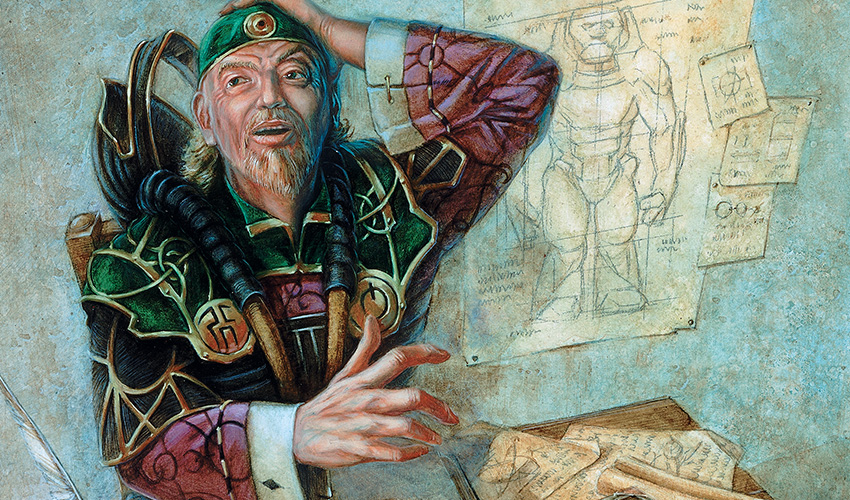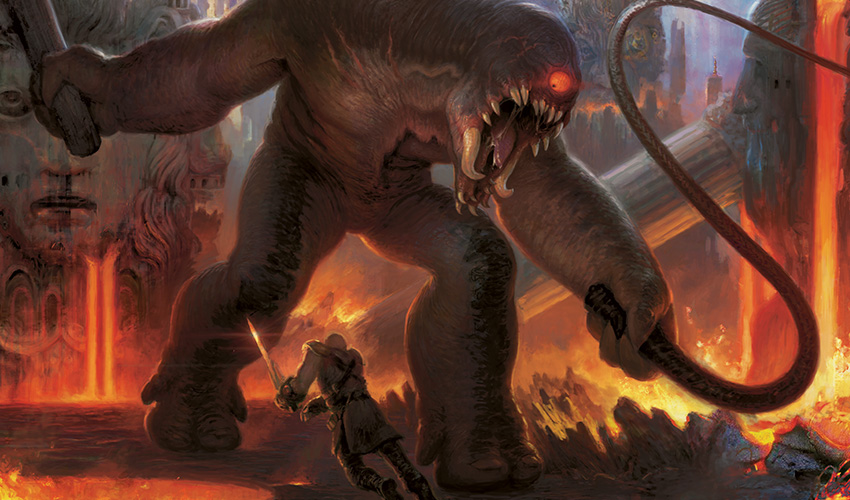Beating the Kobayashi Maru
It has been a super close, back and forth game—and it all comes down to this.
You're in a Kaladesh draft playing a red-white deck while your opponent is playing blue-red. Your opponent beat you down a bunch with red creatures early, but some well-timed removal spells and trades on your end let you stabilize at just 2 life. You managed to take the upper hand for several turns, pecking their life total away down to 5 with your Veteran Motorist.
Unfortunately, your opponent just top-decked a Wind Drake, giving them the final 2 damage they need to punch through. You have to draw an answer this turn or you're going to lose.
You untap.
You pick up the top card of your library.
You take a peek.
And...
Whiff.
As strong as the Augmenter is in this situation, it's not going to help you here.
So that's game, right?
Right?

One of the most iconic scenes in Star Trek II: The Wrath of Khan is the opening: the Kobayashi Maru.
A cadet in Starfleet Academy is being given the Kobayashi Maru simulation. They're on a mock starship and have to make a decision about what to do next. However, the simulation is specifically designed to be a no-win scenario; it's impossible to overcome. It is there to see how the cadet responds to the prospect of having lost.
But, as we later learn, our plucky protagonist Captain Kirk did indeed once take down the simulation using some out-of-the-box thinking. "I don't believe in the no-win scenario," he famously says.
Magic is full of seemingly no-win scenarios: paths where you're dead on board and any course of action is going to lead to your demise. Attack, don't attack—it doesn't make a difference if you're just going to lose to a flier.
Unless, that is, you can find a different solution. One not in the cards you see in front of you. And, unlike Mr. Kirk, who, as it turns out, beat the simulation by cheating and reprogramming it, you can do things entirely above board.
Today, let's talk about these no-win scenarios.
Boldly Going
Magic is a game of inches. (And not just because your cards are inches away from one another.)
Trying to win in these situations isn't always going to work. In fact, it's probably going to work one in 50, maybe one in 100 times. And yet, it's still worth considering. Because that 50th game? That could be the one that makes all the difference. The one that catapults you into the Top 8. The one that's the difference between making Day Two and not. The one that finally makes your friend Mark be quiet about how he's undefeated with his Mizzix of the Izmagnus Commander deck.
And as discussed in "I Concede" a few weeks ago, it's not always right to keep playing at this point. Sometimes the couple minutes are so precious that they're worth preserving. That's for you to weigh.
But with plenty of time left in the round? A crucial Game 3? If you decide to keep playing, then, naturally, you should be doing everything you can inside the rules of Magic to win.
And, what's important to note here is that, unlike most bluffing situations (such as attacking a 2/2 into a 3/3) where it's upside if it works and downside if it doesn't, you're going to lose anyway in these cases—so you have to try whatever works within the rules, however unlikely, to switch that loss to a win. If it doesn't work, then, hey, you were going to lose anyway. And if it does—well, then you just saved the Kobayashi Maru.
Figure Out What Matters
Before you can figure out what you need to do to turn this situation in your favor, step one is to figure out what problem you're trying to solve for.
In the opening situation, it's pretty clear what problem you need to solve for: the Wind Drake that is about to attack you. But a lot of the time, it's a little less clear. Maybe the board is cluttered and building up to an alpha strike. Maybe it's the removal spell for your Platinum Angel that you know your opponent Mystical Tutored for. But, regardless, for any plan to form, first you have to figure out what the problem is.

Once you know the problem, you must figure out what needs to happen to give you a chance.
To go back to the opening scenario, it's simple: you either need your opponent to block with their Wind Drake, or to not attack with their Wind Drake. Either one will give you another turn, which is all you really need.
Once you know that, it's time to execute.
Identify What You Need Them to Believe
Once you've identified what you need to do, you must figure out what would actually help in this situation.
Let's go back to how we're dealing with that Wind Drake. Remember, you're at 2 and they're at 5.
What is the most likely way you could get them to block?
Well, the natural answer is a combat trick. Inspired Charge, for example, is a card you might play in a deck like this. If you have it and they don't block, they're going to die. If you have it and they do block, the creatures just trade.
Another option is to try and make them believe you have something defensive so they don't attack.
Imagine, for a moment, that Aerial Maneuver was a card in Kaladesh.
You could consider not attacking and trying to make them believe you have Aerial Maneuver in your hand and are going to block. Maybe they should hold off a turn until they draw another creature.
You should pick the direction that you think is most likely for them to believe. For example, if you cast Inspired Charge in Games 1 and 2, then they are likely to be thinking about it again in Game 3. If you don't attack, in this situation where you're clearly trying to create a trade, that signals something unusual might be up and they shouldn't attack on their next turn for fear of a flying combat trick.
Some of what you choose should also be dictated by how your opponent has played. For example, if your opponent has very conservatively tried to play around everything, then I would be more inclined to attack since any combat trick puts them as dead.
One other note in this section: don't pick a card for them to play around that doesn't impact their decision-making. For example, if the card you try to make them play around here is Impeccable Timing, it doesn't actually do much for you. Regardless of if they block or if they attack they're going to have Timing cast on them, so from their perspective they're not likely to change up their play. You want to pick a card that really forces them to make the play you'd like them to make.
Create the Reality
My friend Josh grew up in Hollywood, near movie studios. And as a kid, he loved movies. They fascinated him. Whenever he heard a movie was filming near him, he wanted to check it out. But, of course, how was he ever supposed to get close enough to see what was going on?
So, he came up with a plan: he would grab a bucket, fill it with water, and just carry it onto the set.
And you know what? It worked.
"Nobody questions a kid with a bucket on a movie set," he told me. "If you have a bucket and walk with confidence, everybody just believes you're supposed to be there."
Now, to be clear, I certainly don't condone or recommend sneaking into places you shouldn't be. But, when making a bluff in Magic, you need to have the same confidence level as Josh with that bucket: if you don't believe you have the card you need in your hand, neither will your opponent.
You have to create the reality you want to be true.

Once you've decided what card (or kind of card) you want your opponent to believe you have, you need to make your opponent believe that you do actually have it by playing exactly as though you do. (Depending on the level of player you're playing against, you may want to even exaggerate it—generally, exaggerating against stronger players leads them to believe you're bluffing, while against less skilled players it's necessary to make them understand what you're trying to do.)
As a basic example, even though the card is strong, if your plan is to try and bluff an Aerial Maneuver then you shouldn't play your Visionary Augmenter. That makes it clear that you have nothing in your hand and it's safe to attack.
For something more nuanced, if your plan is to bluff Inspired Charge (or an offensive burn spell, or any number of attacking-kills-them cards) you may want to do something like confirm what their life total is—an excited, "You're at 5, right?" followed by quickly attacking is a great way to make your opponent question what the right play is.
Let me pose you a different scenario. You're at 2 life. Your opponent is at 6. You have a Cyclops Tyrant. They have a Goblin Piker. You draw your card for the turn and it's just a Mountain. What do you do?
If you attack, you're certainly going to lose: the swing back from the Piker will kill you. They could block, though it's unlikely. However, if you don't attack, the Cyclops can't block, so you'll lose. So attack, right, and hope they block?
Well, here's another option for you: what if you don't attack and hope they don't realize the Cyclops can't block?
Normally, I play as though my opponent is going to play optimally. But in a situation like this, you have to go out on a limb. And considering the limit on the Cyclops is often relegated to the back of your mind, there's a chance your opponent doesn't even remember that underneath all of that intimidate reminder text, the Cyclops can't block the Piker.
Now, to be absolutely clear, if they attack with the Piker you can't try and block it. That's not a legal play. However, if you leave your Tyrant untapped and they don't attack, nothing untoward has occurred—and you can live to see another turn.
But if you hesitate too much, pick up and read the Cyclops for a while, or any number of things, this plan might not work at all! For a bluff at this level to work, you need to play crisply and with confidence in the reality you want to be true.

Off-Topical
Hopefully you enjoyed this look at coming back from no-win scenarios! It will only matter every now and then, but it's something to practice in every game—and then when it does matter, it can be the difference between winning and losing. (And you'll feel pretty smart to boot.)
Switching gears a bit, let's talk about something else: one of my upcoming columns!
Every year, I write a Topical Blend column. Inspired by Mark Rosewater, I take one Magic topic, one non-Magic topic, and then write an article that somehow combines the two. In the past you've seen things like Doctor Who and some of my favorite decks or near-death experiences I've had and bad deck-building habits.
As usual, you, the reader, get to vote on the topics for this article. So, here are your options. (Many as suggested by my Twitter and Tumblr followers.)
Vote either by tweeting your vote to me or by emailing me with your votes in the subject line.
MAGIC TOPIC
- Six-plus mana creatures
- Best uses for cards I've designed
- Building your own deck versus net-decking
- Counterspells
- Evaluating new cards
- How to choose a tournament deck
- How to playtest
- Metagaming properly
- Red commons
- Ways to prevent mana problems
NON-MAGIC TOPIC
- Baseball
- Bearsnakes
- Cosplay I've worn
- Crazy parties
- Disneyland
- My favorite movies
- My hat
- Restaurants
- Travel stories
- Writing articles
Vote now, and then expect the results in an article toward the end of the year. I can't wait to see what I'm writing about this time!
That about wraps up this week! If you have any thoughts or questions, please feel free to send me a tweet or ask me a question on my Tumblr. You can also always e-mail me in English at beyondbasicsmagic@gmail.com.
Talk with you again next week!
—Gavin
@GavinVerhey
GavInsight

